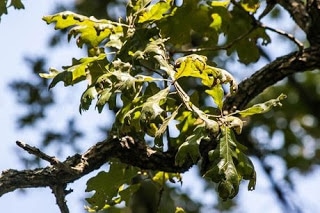A Midwest Center for Investigative Reporting effort found that dicamba, a herbicide known for drifting over and damaging nearby crops, is also responsible for killing millions of trees in the Midwest and South. That could be devastating news for orchards.

(Photo by Illinois Department of Natural Resources)
“Forest health experts said trees are being damaged from Indiana to Kansas, from North Dakota to Arkansas. Cupped-up leaves, the most easily recognized symptom, can be seen in towns miles away from agricultural fields, as well as in nature preserves and state parks set aside as refuges for wildlife, experts said,” Jonathan Hettinger reports. “In some areas, the damage is so severe that tree mortality is higher than from the Emerald Ash Borer, an insect that has killed tens of millions of trees across 25 states.”
Farmers have been increasingly spraying dicamba and other volatile herbicides, such as 2,4-D, in recent years, Hettinger reports. In early June, a federal court essentially banned sales of dicamba-based herbicides for the next six months, after finding that the Environmental Protection Agency hadn’t done its due diligence in 2018 when reauthorizing the chemical until December 2020. The same environmental groups filed another lawsuit with the same complaint about 2,4-D, but it’s still pending in court. The EPA said farmers can still spray already-purchased dicamba through July.
In February, a Missouri peach farmer was awarded a $265 million verdict in court after suing Bayer and BASF, alleging that their dicamba-based herbicides had damaged his orchards.
The Rural Blog is a publication of the Institute for Rural Journalism and Community Issues based at the University of Kentucky.






